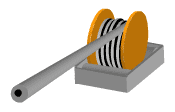Storage and transport
During transport, storage and laying, the PROFIBUS cable must be closed with a shrink cap at both ends. This prevents any accumulation of moisture and dirt within the PROFIBUS cable.

Temperature
The manufacturer specifies minimum and maximum temperatures for PROFIBUS cable. The cable must be kept within these limits otherwise it may not meet the required mechanical and optical specifications. The cable must be routed to avoid areas where the temperature is outside the specified limits.
The temperature values can be found on the manufacturer’s data sheets. Some manufacturers print temperature data on the cable sheath
The temperature range for PROFIBUS cable typically lies between -5 °C and +50°C.
 |
